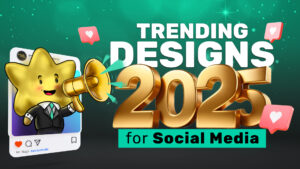Introduction:
The movie industry is one of the fastest-growing sectors worldwide, and poster design plays a pivotal role in marketing films and connecting with the audience. Indian cinema, with its diverse genres and regional influences, has witnessed a remarkable transformation in movie poster design, mirroring the evolving dynamics of both cinema and graphic art. Let’s take a trip down memory lane to explore the captivating evolution of Bollywood posters.

1950’s – The Golden Era:
In the early days of Indian cinema, movie posters were intricately hand-painted with vibrant colors. Bold typography and dramatic poses of actors created eye-catching designs that set the stage for the film’s narrative. An iconic example is the poster for “Shree 420,” featuring Nargis Dutt and Raj Kapoor. The gripping red title beautifully conveyed love and action.

1970’s-1980’s – The Era of Larger-Than-Life:
Bollywood transitioned from hand-painted posters to a more photographic approach. Posters aimed to portray film stars in a larger-than-life manner. Smart taglines and bold typography became essential elements in poster design. “Sholay” and “Don” are notable examples with action-packed visuals and stylized fonts, setting the mood for these iconic films.

1990’s – Embracing Contemporary Trends:
As technology advanced, the 90s brought a shift towards more contemporary and graphic design-oriented posters. Graffiti-style fonts and photography remained prominent. Films like “Andaaz Apna Apna” and “Dilwale Dulhania Le Jayenge” incorporated vibrant colors, quirky typography, and dramatic poses to tell their stories.

2000 – The Millennial Shift:
The 2000s marked a significant shift as Bollywood posters adopted a minimalistic and focused design approach. These posters emphasized star power and catchy fonts against uncluttered backgrounds. “Kuch Kuch Hota Hai” is a prime example with its simplicity, featuring the cast against a white background with neon blue typography.

2010 – Embracing Contemporary Design Elements:
This decade saw Bollywood posters embracing modern design elements and digital innovations. Clean lines, high-resolution images, and sleek typography became the norm. Special effects and digital artwork enhanced posters, while social media integration encouraged online engagement. Films like “Dabangg” and “3 Idiots” showcased these design trends.

2020 – The OTT Era:
With the pandemic pushing the entertainment industry towards OTT platforms, Bollywood posters continued their minimalistic look. Digital tools allowed for special effects and countdowns to build anticipation. Social media engagement became a standard practice, with users encouraged to share their content and participate in challenges. “Ludo” exemplifies this trend with its colorful, playful design.

Present Day – Advanced and Detailed:
Today, Bollywood posters are more advanced and detailed, with a focus on concept and clarity. Special effects enhance the quality of designs, and some films even have separate posters for their song releases. The integration of technology and the rise in movie production have ushered in a new era of poster design.
Conclusion:
In conclusion, the evolution of Bollywood poster design has been a captivating journey, reflecting changing artistic trends, technological advancements, and evolving audience preferences. From the colorful and hand-painted posters of the past to the modern, digitally enhanced designs of recent years, Bollywood movie posters continue to play a crucial role in generating interest and excitement for films.





